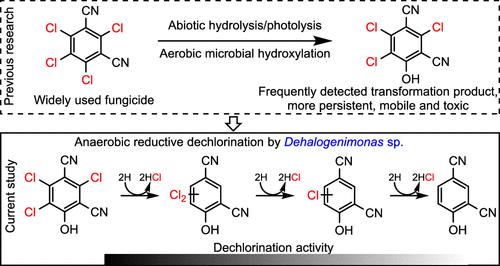当前位置:
X-MOL 学术
›
Environ. Sci. Technol.
›
论文详情
Our official English website, www.x-mol.net, welcomes your feedback! (Note: you will need to create a separate account there.)
Complete Reductive Dechlorination of 4-Hydroxy-chlorothalonil by Dehalogenimonas Populations
Environmental Science & Technology ( IF 10.8 ) Pub Date : 2022-08-11 , DOI: 10.1021/acs.est.2c02574 Wenjing Qiao 1 , Guiping Liu 1 , Mengya Li 1 , Xiaojing Su 1 , Lianghua Lu 2 , Shujun Ye 3 , Jichun Wu 3 , Elizabeth A Edwards 4 , Jiandong Jiang 1
Environmental Science & Technology ( IF 10.8 ) Pub Date : 2022-08-11 , DOI: 10.1021/acs.est.2c02574 Wenjing Qiao 1 , Guiping Liu 1 , Mengya Li 1 , Xiaojing Su 1 , Lianghua Lu 2 , Shujun Ye 3 , Jichun Wu 3 , Elizabeth A Edwards 4 , Jiandong Jiang 1
Affiliation

|
Chlorothalonil (2,4,5,6-tetrachloroisophthalonitrile, TePN) is one of the most widely used fungicides all over the world. Its major environmental transformation product 4-hydroxy-chlorothalonil (4-hydroxy-2,5,6-trichloroisophthalonitrile, 4-OH-TPN) is more persistent, mobile, and toxic and is frequently detected at a higher concentration in various habitats compared to its parent compound TePN. Further microbial transformation of 4-OH-TPN has never been reported. In this study, we demonstrated that 4-OH-TPN underwent complete microbial reductive dehalogenation to 4-hydroxy-isophthalonitrile via 4-hydroxy-dichloroisophthalonitrile and 4-hydroxy-monochloroisophthalonitrile. 16S rRNA gene amplicon sequencing demonstrated that Dehalogenimonas species was enriched from 6% to 17–22% after reductive dechlorination of 77.24 μmol of 4-OH-TPN. Meanwhile, Dehalogenimonas copies increased by one order of magnitude and obtained a yield of 1.78 ± 1.47 × 108 cells per μmol Cl– released (N = 6), indicating that 4-OH-TPN served as the terminal electron acceptor for organohalide respiration of Dehalogenimonas species. A draft genome of Dehalogenimonas species was assembled through metagenomic sequencing, which harbors 30 putative reductive dehalogenase genes. Syntrophobacter, Acetobacterium, and Methanosarcina spp. were found to be the major non-dechlorinating populations in the microbial community, who might play important roles in the reductive dechlorination of 4-OH-TPN by the Dehalogenimonas species. This study first reports that Dehalogenimonas sp. can also respire on the seemingly dead-end product of TePN, paving the way to complete biotransformation of the widely present TePN and broadening the substrate spectrum of Dehalogenimonas sp. to polychlorinated hydroxy-benzonitrile.
中文翻译:

脱卤单胞菌对 4-羟基百菌清的完全还原脱氯
百菌清(2,4,5,6-四氯间苯二甲腈,TePN)是世界上使用最广泛的杀菌剂之一。其主要的环境转化产物 4-羟基-百菌清(4-羟基-2,5,6-三氯间苯二甲腈,4-OH-TPN)具有更强的持久性、流动性和毒性,并且与其母体化合物 TePN。从未报道过 4-OH-TPN 的进一步微生物转化。在这项研究中,我们证明了 4-OH-TPN 通过 4-羟基-二氯间苯二甲腈和 4-羟基-单氯间苯二甲腈经历了完全的微生物还原脱卤为 4-羟基-间苯二甲腈。16S rRNA 基因扩增子测序表明,脱卤单胞菌属在 77.24 μmol 的 4-OH-TPN 还原脱氯后,物种从 6% 富集到 17-22%。同时,脱卤单胞菌的拷贝数增加了一个数量级,每 μmol Cl释放的产量为 1.78 ± 1.47 × 10 8 个细胞(N = 6),表明 4-OH-TPN 作为有机卤化物呼吸的末端电子受体脱卤单胞菌属。通过宏基因组测序组装了脱卤单胞菌属物种的基因组草图,其中包含 30 个推定的还原脱卤酶基因。嗜酸杆菌属,醋杆菌属,和甲烷球菌属spp. 被发现是微生物群落中主要的非脱氯种群,它们可能在脱卤单胞菌物种对 4-OH-TPN 的还原脱氯中起重要作用。这项研究首先报告了Dehalogenimonas sp。还可以在 TePN 看似死胡同的产物上进行呼吸,为完成广泛存在的 TePN 的生物转化铺平道路,拓宽 Dehalogenimonas sp. 的底物谱。为多氯羟基苄腈。
更新日期:2022-08-11
中文翻译:

脱卤单胞菌对 4-羟基百菌清的完全还原脱氯
百菌清(2,4,5,6-四氯间苯二甲腈,TePN)是世界上使用最广泛的杀菌剂之一。其主要的环境转化产物 4-羟基-百菌清(4-羟基-2,5,6-三氯间苯二甲腈,4-OH-TPN)具有更强的持久性、流动性和毒性,并且与其母体化合物 TePN。从未报道过 4-OH-TPN 的进一步微生物转化。在这项研究中,我们证明了 4-OH-TPN 通过 4-羟基-二氯间苯二甲腈和 4-羟基-单氯间苯二甲腈经历了完全的微生物还原脱卤为 4-羟基-间苯二甲腈。16S rRNA 基因扩增子测序表明,脱卤单胞菌属在 77.24 μmol 的 4-OH-TPN 还原脱氯后,物种从 6% 富集到 17-22%。同时,脱卤单胞菌的拷贝数增加了一个数量级,每 μmol Cl释放的产量为 1.78 ± 1.47 × 10 8 个细胞(N = 6),表明 4-OH-TPN 作为有机卤化物呼吸的末端电子受体脱卤单胞菌属。通过宏基因组测序组装了脱卤单胞菌属物种的基因组草图,其中包含 30 个推定的还原脱卤酶基因。嗜酸杆菌属,醋杆菌属,和甲烷球菌属spp. 被发现是微生物群落中主要的非脱氯种群,它们可能在脱卤单胞菌物种对 4-OH-TPN 的还原脱氯中起重要作用。这项研究首先报告了Dehalogenimonas sp。还可以在 TePN 看似死胡同的产物上进行呼吸,为完成广泛存在的 TePN 的生物转化铺平道路,拓宽 Dehalogenimonas sp. 的底物谱。为多氯羟基苄腈。











































 京公网安备 11010802027423号
京公网安备 11010802027423号